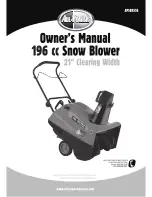
c. Fill fuel tank outdoors with extreme care. Never fill fuel tank indoors.
d. Replace fuel cap securely and wipe up spilled fuel.
e. Never store fuel or snow thrower with fuel in the tank inside of a building where fumes may reach an open
flame or spark.
f. Check fuel supply before each use, allowing space for expansion as the heat of the engine (motor) and/or
sun can cause fuel to expand.
g. Never fill containers inside a vehicle or on a truck or trailer bed with a plastic liner. Always place containers
on the ground, away from vehicle, before filling.
h. When practical, remove gas-powered equipment from the truck or trailer and refuel it on the ground. If this
is not possible, then refuel such equipment on a trailer with a portable container, rather than from a
gasoline dispenser nozzle.
i. Keep the nozzle in contact with the rim of the fuel tank container opening at all times, until refueling is
complete. Do not use a nozzle lock-open device.
j. If fuel is spilled on clothing, change clothing immediately.
5. Let engine (motor) and snow thrower adjust to outdoor temperatures before starting to clear snow.
6. Always wear safety glasses or eye shields during operation or while performing an adjustment or repair to
protect eyes from foreign objects that may be thrown from the snow thrower.
OPERATION
1. Do not operate this snow thrower if you are taking drugs or other medication which can cause drowsiness or
affect your ability to operate this snow thrower.
2. Do not use the snow thrower if you are mentally or physically unable to operate the snow thrower safely.
3. Do not put hands or feet near or under rotating parts. Keep clear of the discharge opening at all times.
4. Exercise extreme caution when operating on or crossing gravel drives, walks or roads. Stay alert for hidden
hazards or traffic.
5. After striking a foreign object, stop the engine (motor), remove the wire from the spark plug, thoroughly
inspect snow thrower for any damage, and repair the damage before restarting and operating the snow
thrower.
6. If the snow thrower should start to vibrate abnormally, stop the engine (motor) and check immediately for the
cause. Vibration is generally a warning of trouble.
7. Stop the engine (motor) whenever you leave the operating position, before unclogging the auger/impeller
housing or discharge chute and when making any repairs, adjustments, or inspections.
8. When cleaning, repairing, or inspecting, make certain the auger/impeller and all moving parts have stopped
and all controls are disengaged. Disconnect the spark plug wire and keep the wire away from the spark plug
to prevent accidental starting.
9. Take all possible precautions when leaving the snow thrower unattended. Disengage the auger/ impeller,
stop engine (motor), and remove key.
10. Do not start or run engine in enclosed area, even if doors or windows are open. Exhaust fumes are
dangerous (containing
CARBON MONOXIDE
, an
ODORLESS
and
DEADLY GAS
).
11. Exercise extreme caution if operating on steep slopping surfaces.
12. Do not clear snow across the face of slopes. Exercise extreme caution when changing direction on slopes.
Do not attempt to clear steep slopes.
13. Never operate the snow thrower without proper guards, plates or other safety protective
devices in place.
4






































